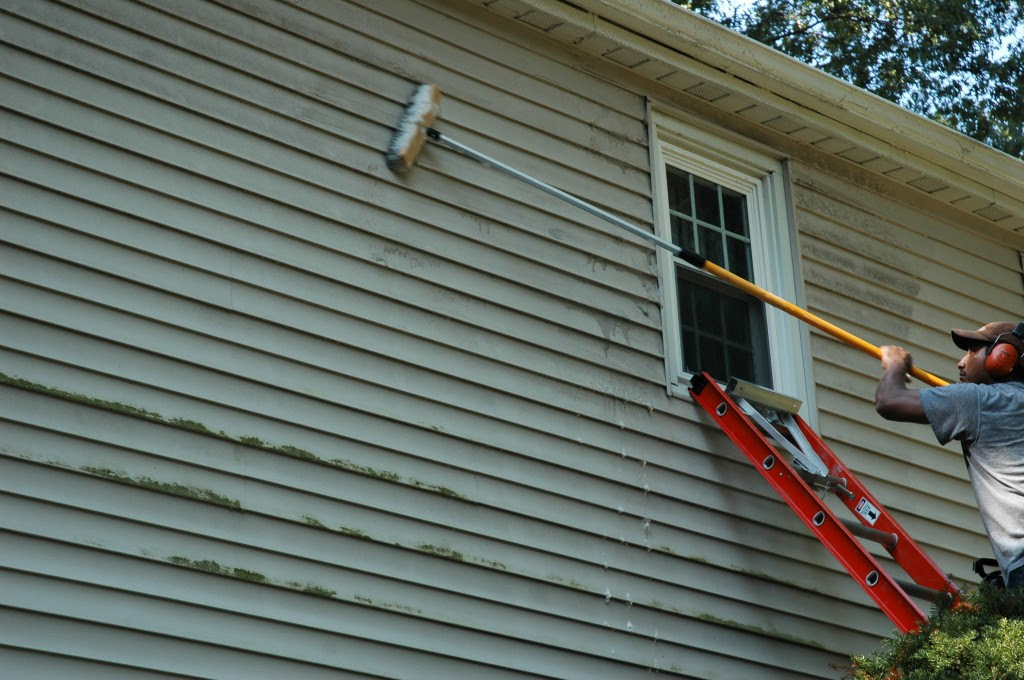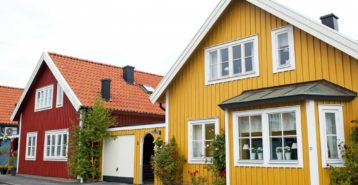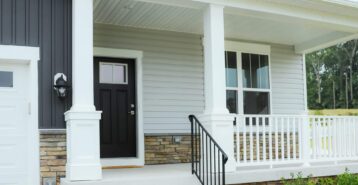What Is the Best Way to Clean House Siding?
The best approach balances low pressure, the right cleaner, and gentle tools. Start with the least aggressive method — a garden hose, a soft brush, and a mild cleaner — and escalate only if needed. Always test in a small, hidden area first, and never mix cleaners.
How to Clean Siding by Hand
You’ll need:
- Garden hose with spray nozzle
- Soft-bristle brush on an extension pole, or a microfiber mop
- Bucket, warm water, and a mild detergent (dish soap works for many materials)
- Ladder with stabilizer, protective eyewear, and gloves
- Prep the Area: Close windows, cover outlets, and move decor away from the walls. Point sprinklers away from the house.
- Rinse From Bottom to Top: Lightly wet a small section to loosen dirt.
- Wash Gently: Apply cleaner with a brush in overlapping strokes. Work from the bottom up to avoid streaking.
- Rinse Top to Bottom: Flush each finished section right away so residue does not dry.
- Spot Treat: Address mold, algae, rust, or insect stains with a material-safe solution.
- Final Check: Touch up missed spots, then let the surface dry fully before sealing or painting.
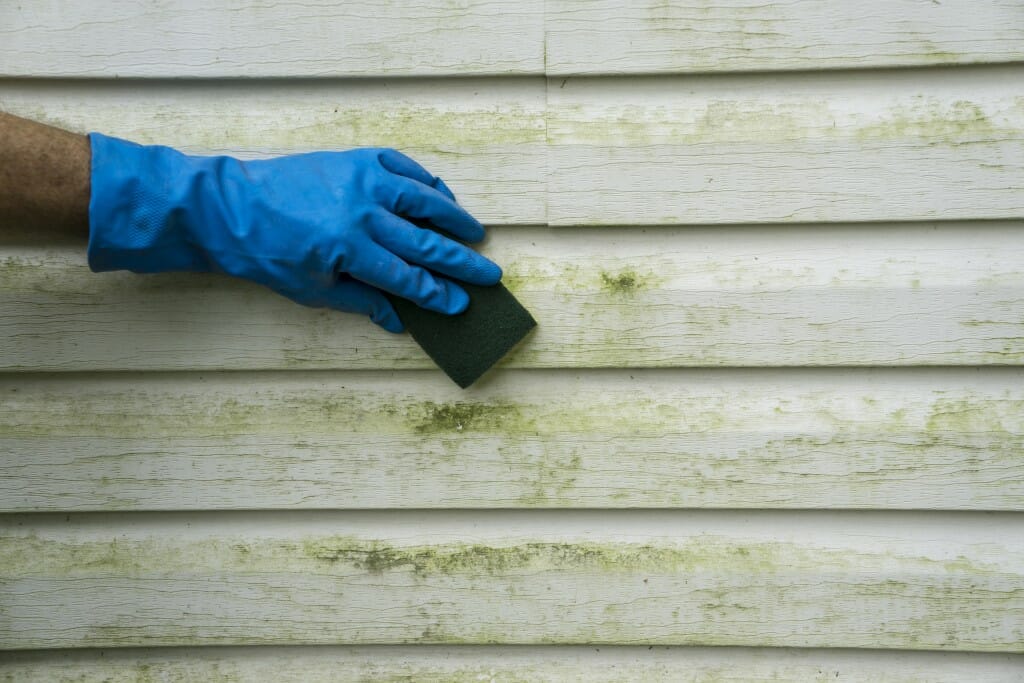
How to Remove Mold From Siding
Mold and mildew need moisture and shade. Fix moisture sources first — clogged gutters, leaky hose bibs, or overspray — then clean.
Safety: Wear gloves and eye protection. Never mix bleach with ammonia, vinegar, or other cleaners.
Vinyl and Aluminum
- Mix 70% water and 30% white vinegar for light growth, or 1 quart household bleach in 3 quarts water with a few drops of dish soap for heavier staining.
- Apply, let sit for 5 to 10 minutes, scrub gently, then rinse thoroughly.
Fiber Cement
- Use dish soap and warm water or a non-abrasive, siding-safe cleaner.
- Scrub with a soft sponge, then rinse. Avoid pressure washing.
Wood (Cedar, Redwood, Pine)
- Start with equal parts white vinegar and warm water.
- For stubborn areas, use oxygenated bleach (per label) — not chlorine bleach — to avoid fiber damage or discoloration.
- Rinse well and allow wood to dry completely before sealing or staining.
Stucco and Brick
- Rinse gently.
- Apply dish soap and water for light staining.
- For heavier growth, use borax solution (2 gallons warm water, ½ cup borax, 2 tablespoons dish soap).
- Scrub with a soft brush and rinse at a 45-degree angle.
Our Top Cleaning Tips
- Be gentle. Hand wash before considering machines.
- Test first. Always clean a small space with your solution to ensure it doesn’t harm your siding.
- Work in shade. Clean on a cool, overcast day to prevent streaks.
- Clean bottom to top, rinse top to bottom. This reduces water marks.
- Protect landscaping. Pre-wet plants, and rinse them after cleaning.
- Mind the joints. Keep water away from laps, seams, and weep holes.
- Check and caulk. Seal cracks, gaps, and nail penetrations before washing.
- Skip abrasives. Avoid steel wool, harsh pads, and gritty cleansers.
- Know when to hire. Two-story homes, extensive mold, lead-based paint, or damaged siding are best left to pros.
Is It Better to Pressure Wash or Soft Wash Siding?
Soft washing uses low pressure with a cleaner to lift grime — safer for most materials. Pressure washing uses high pressure to blast off dirt — faster, but higher risk. Many manufacturers discourage pressure washers, especially on wood and fiber cement. If you use one, choose low pressure and the correct nozzle, and keep your distance.
How to Clean Siding With a Pressure Washer
- Set Pressure to Low: Aim for 1,200 to 1,500 PSI on most siding. Stay lower on wood and painted surfaces.
- Use a Wide Fan: 25- or 40-degree nozzle.
- Keep Your Distance: At least 24 inches from the surface, sweeping at a 45-degree angle.
- Pre-Rinse and Pre-Soak: Loosen dirt first; let cleaner dwell per label, then rinse.
- Avoid Windows, Vents, and Seams: Never spray upward into laps.
How to Clean Siding Without a Pressure Washer
- Garden Hose + Nozzle: Rinse, scrub with a soft brush and cleaner, then rinse again.
- Pump Sprayer: Apply solution evenly to large areas before brushing.
- Extendable Tools: Microfiber mop or soft brush on a pole for high spots.
- Targeted Spot Cleaners: Use material-safe mold and mildew removers as needed.
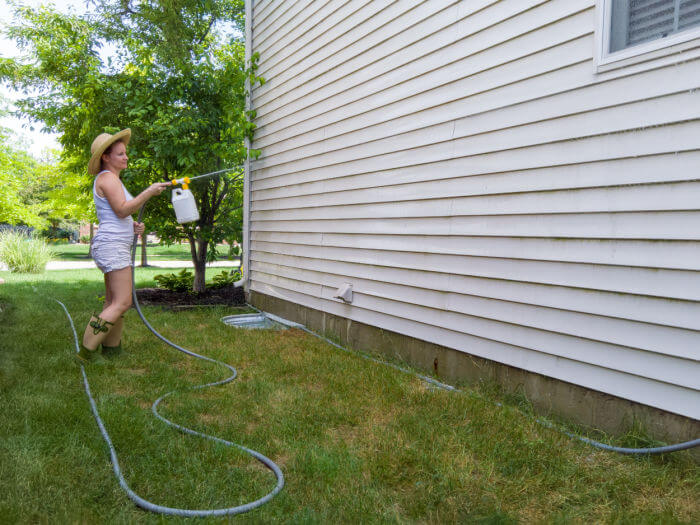
How to Clean Different Types of Siding
Vinyl
- Rinse lightly. Wet a manageable section.
- Wash with mild soap. Mix warm water with a few drops of dish soap, or use a vinyl-safe cleaner.
- Brush gently. Use a soft brush, working from the bottom up.
- Rinse thoroughly. Flush from the top down to remove residue.
- Spot treat mold or algae. Use vinegar solution (70% water, 30% vinegar) or dilute bleach solution as noted above.
» Read our vinyl siding buying guide.
How to Clean Vinyl Siding Without Scrubbing
Pre-treat with a vinyl-safe cleaner in a pump sprayer, let it dwell per directions, then rinse with a strong hose stream. Repeat on stubborn areas. Light annual build-up often releases without heavy brushing.
Can You Pressure Wash Vinyl Siding?
We don’t recommend pressure washing vinyl. It’s possible, but risky. If you proceed, keep pressure near 1,200 PSI, use a 40-degree nozzle, stand at least 24 inches away, and spray downward at a 45-degree angle. Avoid seams, windows, soffits, and electrical fixtures. When in doubt, hire a pro.
Can You Power Wash Vinyl Siding?
“Power wash” usually means heated water at high pressure — which increases damage risk. Avoid heated, high-pressure washing on vinyl.
What Should You Not Clean Vinyl Siding With?
- Abrasive pads or scrubbers
- Undiluted bleach or solvents (acetone, lacquer thinner, paint removers)
- Harsh, gritty powders
- Pressure nozzles narrower than 25 degrees
Best Homemade Vinyl Siding Cleaner
- Everyday Grime: 1 gallon warm water + a few drops of dish soapc
- Mold or Algae: 70% water + 30% white vinegar; or 1 quart bleach in 3 quarts water with a small amount of dish soap
- Insect Residue: 1 gallon warm water + 1 cup borax
Can I Use Dawn Dish Soap to Clean Vinyl Siding?
Yes. Mix a few drops of Dawn in a bucket of warm water. Apply with a soft brush or microfiber mop, and rinse thoroughly.
Aluminum
- Rinse Gently: Use a hose to remove loose debris.
- Wash With Mild Soap: Mix warm water and dish soap, or use a metal-safe siding cleaner.
- Brush Softly: Use a soft brush or non-abrasive pad; avoid scouring.
- Treat Oxidation: If chalky residue remains, use an aluminum-safe oxidation remover per label, then rinse well.
- Protect the Finish: After drying, consider a siding-safe, non-abrasive polish or a fresh coat of paint if the finish is worn.
- Skip High Pressure: High PSI can dent panels or drive water behind laps.
» Read our aluminum siding buying guide.
Natural Wood
- Routine Clean: Equal parts white vinegar and warm water. Spray, gently brush with the grain, and rinse.
- Stubborn Grime: Use oxygenated bleach mixed per label — not chlorine bleach. Test a small area, allow up to 20 minutes, then rinse thoroughly.
- Aftercare: Let wood dry fully, then reseal or stain as needed to prevent moisture intrusion.
» Read our wood siding buying guide.
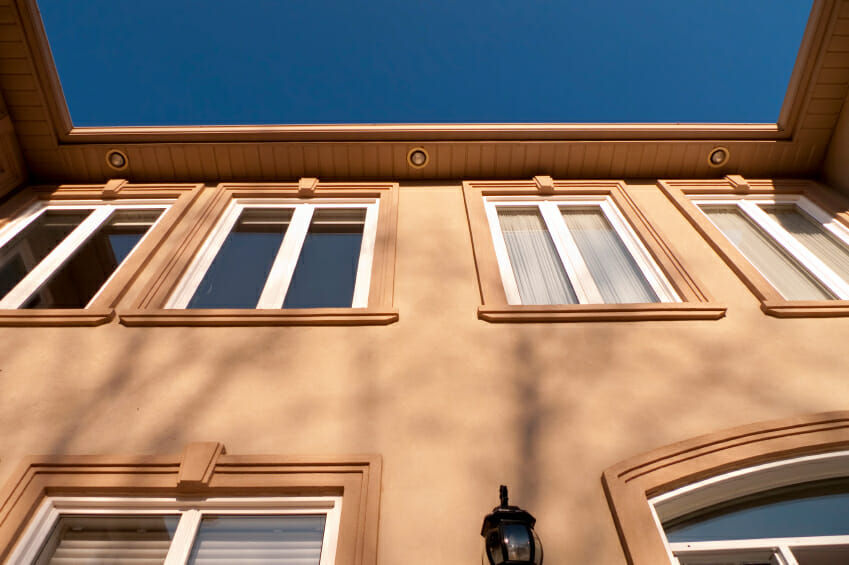
Fiber Cement
- Use Soft Tools Only: Microfiber cloth or sponge — no stiff bristles.
- Mild Cleaner: Dish soap in warm water works well.
- No Pressure Washer: High pressure can damage finishes and force water behind boards.
- Rinse Well: Work in sections and rinse top to bottom.
» Read our fiber cement siding buying guide.
Stucco
- Inspect First: Repair cracks and gaps before washing to prevent trapped moisture.
- Rinse Lightly: Use a hose or very low pressure.
- Apply Cleaner: Dish soap and water for light soil; borax solution for heavier grime.
- Scrub With a Soft Brush: Avoid aggressive tools.
- Rinse at 45 Degrees: Keep water moving downward and away from seams.
» Read our stucco siding buying guide.
Brick
- Start With Water Only: Many stains release with a thorough rinse and soft brushing.
- Use Mild Detergents: Avoid acidic cleaners unless you follow manufacturer guidance.
- Protect Mortar: Do not concentrate pressure on joints.
- Efflorescence: Brush dry with a stiff nylon brush. Avoid water, which can dissolve salts back into the surface.
» Read our brick siding buying guide.
Ongoing Siding Care and Maintenance
- Inspect Quarterly: Look for cracks, loose panels, missing caulk, and peeling paint.
- Keep Vegetation Trimmed: Shrubs and vines trap moisture and invite insects.
- Clean Gutters: Overflowing gutters stain siding and feed mildew.
- Mind Irrigation: Aim sprinklers away from walls to reduce mineral stains.
- Schedule a Yearly Clean: Most homes benefit from a deep clean each spring. Heavily shaded or roadside homes may need more frequent care.
By using the right tools, cleaners, and technique, you can keep your siding looking new and extend its life — without risking damage. If your home is two stories, has extensive staining, or needs repairs before cleaning, consider hiring a siding professional for safe, efficient results.
Compare top-rated siding pros in your area.
Read real homeowner reviews, explore qualifications, and view promotions. Modernize makes it easy to browse professionals and find one that will be perfect for your project.
